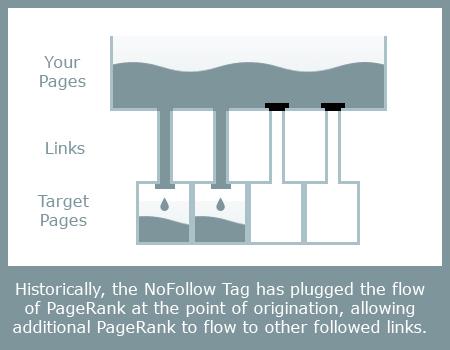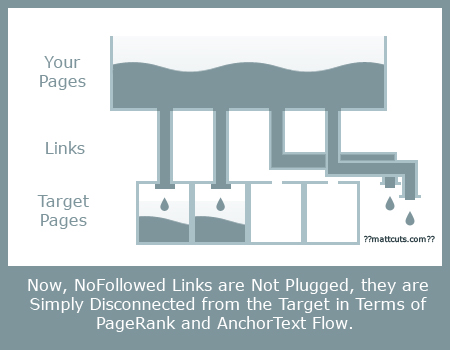NoFollow and PageRank Sculpting Roundup: Changes and Implications
Matt Cutts has decided to reveal a little more about Google’s internal changes that brought upon debate regarding the use of the NoFollow tag and PageRank Sculpting. While there has been quite a bit of discussion, I wanted to take a moment to wrap up what has happened and what the implications of these are for white and black-hat techniques.
What Has Changed
Think of your webpage as a water tower and links as pipes from that water tower to other smaller water towers. Historically, a “nofollow” tag was like capping the one of the pipes so that no water would flow to the terminating water tower. Google has changed this, though. Instead of capping the pipe, they merely divert it into the abyss. The link still impacts your page’s ability to pass on PageRank, but does not benefit the terminating page.


Implications for PageRank Sculpting
These new changes effectively curtail the use of NoFollow to accomplish PageRank sculpting. Applying NoFollow to certain links on your page will not increase the flow to other pages on your site. However, this does not impact the use of other PageRank Sculpting techniques such as:
- Selective Link Addition like Second Page Poaching which increase the volume of links pointing to important pages on your site
- Select Link Removal will still allow a greater percentage of PageRank to flow to important pages.
- Pseudo-Links (using javascript and onClick events create HTML entities that function as links): The use of these types of links in place of NoFollow will allow a greater percentage of PageRank to flow to important pages.
Implications for Blackhat / Negative SEO
Unfortunately, these changes give reason to Blackhats to fire up their link-spam apps once again. While automated NoFollow usage had greatly limited the SEO value of link-spam across popular web software like WordPress, these new changes make Link Spam a viable method for decreasing the value of links pointing to a competitor’s site.
If a competitor has a successful viral campaign, or acquires a large number of blog links, you can (theoretically) effectively diminish the value of those links by commenting on those pages and decreasing the percentage of PageRank flowed to the competitor’s link. Because the point is to diminish the value with a nofollowed link, the perpetrator can use any URL he/she wishes (google, wikipedia, etc.) making it difficult for modern link-spam prevention tools like Akismet and LinkSleeve to find patterns and prevent the spam.
Thoughts and Considerations
At this point, I would recommend that most websites do nothing. The NoFollow change does not hurt anyone beyond where they were prior to NoFollow. In all actuality, it simply handles nofollow as it was intended – a method to prevent PageRank from flowing to untrusted links – nothing more nothing less.
No tags for this post.



Thank-you for explaining the changes regarding NoFollow. I was wondering what I should do so your article was quite helpful. I also had not heard about second page poaching so will read up on that as well.
You make an excellent point about link spamming to reduce value of what links are on the page. One of the more interesting things about Matt’s article is how he said they made this change over a year ago. It’s a stark reminder how Google can change and non one notices.
I have to admit I’m guilty of link sculpting using nofollow. Hopefully it won’t turn into a penalty.